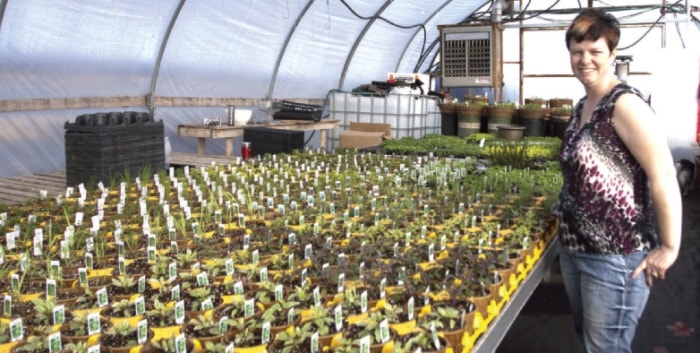A few bright flowers mixed in with home gardens can lead to a better yield at the end of the season by helping keep unhelpful bugs at bay while inviting the helpful ones into the garden.
Marigolds, with their bright ruffled golden flowers, can help keep away cabbage moths, which simply can’t abide the flower.
Borage will help attract bees and other pollinators, as it’s extremely attractive to those insects. Calendula and Nasturtiums are edible plants that can help create borders in the garden and look pretty to boot.
And while they aren’t any particular help to gardens, citronella geraniums will help keep away mosquitos, which is a great help to the gardener, according to Beth Fulton.
For home growers, the right mix of plants is just as important as picking the right place to set a garden and ensuring the soil is healthy and free of pests like disease and bugs, said Fulton, one of the owners of Echoglen Gardens south of Donalda.
Fulton has been in business with Echoglen Gardens for nearly a decade now, and for years before that, she worked at a garden centre in Red Deer. Her love affair with all growing things began in her childhood, though.
“I grew up doing this,” Fulton said. “My mom had a two-acre garden. I always had a portion of it and I grew up doing it. Everyone wants to be a kid and play in the dirt, and I get to make a living out of it. How great is that?”
“Anything and everything” will grow well in prairie soil, especially here in central Alberta, but some plants will do better if planted from sprouted plants or from seeds.
“You don’t want to put a tomato seed in the ground, because you’ll never get tomatoes,” Fulton explained.
“You can plant a plant, though, and get a yield. A lot of people do it.”
When picking a place for a new garden, the first thing gardeners need to consider is light and water.
“In order for vegetables to produce and grow, they need a minimum of six hours of direct, non-shadow sunlight,” she said. “That’s one of the first challenges.
“You can have a bright sunny place without good access to water, which means you will have to bring in water. You can have a place with great water but not enough light, and that just won’t work.”
Once a bright and sunny place is found, the next step is soil acidity, or PH.
“You may find a sunny spot, but the soil isn’t right for growing the type of plants you want,” Fulton said. In some cases, PH can be balanced, but in other cases it could simply be too acidic, or too base, for the effort.
Soil nutrients are important to check as well, as some soils, especially ones that have been used for gardening or farming before, can suffer from lesser nutrients. A good compost or manure can really help there.
“You can crush eggshells and put them around your garden to help keep out slugs,” Fulton said. The slimy creepy-crawlies can’t cross over the sharp shells, and the shells in turn biodegrade and release nutrients into the soil.
When planting root vegetables, like turnips or potatoes, mixing in crushed eggshells around the sprout can help keep away maggots as well. So instead of pulling up vegetables in the fall and seeing creepy crawlies, a bit of shell can result in a healthier plant.
It’s important for home gardeners to keep track of where they plant what every year, so they too can ensure crop rotation. Though home gardens are smaller than wide fields of grain or canola, like these crops they need to be rotated to prevent stripping the soil of nutrients and prevent the spread of diseases, Fulton noted.
“Make yourself a map,” she said. “If you planted peas in one place, plant something different the next year.”
Rookie Gardener Tips
For people new to gardening, Fulton has a few tips.
“Avoid overplanting,” she said. One of the most common rookie mistakes are planting seeds too close, resulting in crowded plants.
Plants need space for roots to expand and for air to flow, but when the soil is barren it’s easy to plant them too close without realizing how much they’ll spread.
“Then there’s the trial and error of watering,” Fulton added. Rookie gardeners often swing far to the left or right on the watering scales, drowning or parching their plants. The best time of day to water is in the morning and in the evening, before the sun reaches its height and can evaporate the water before the plants can absorb it.
